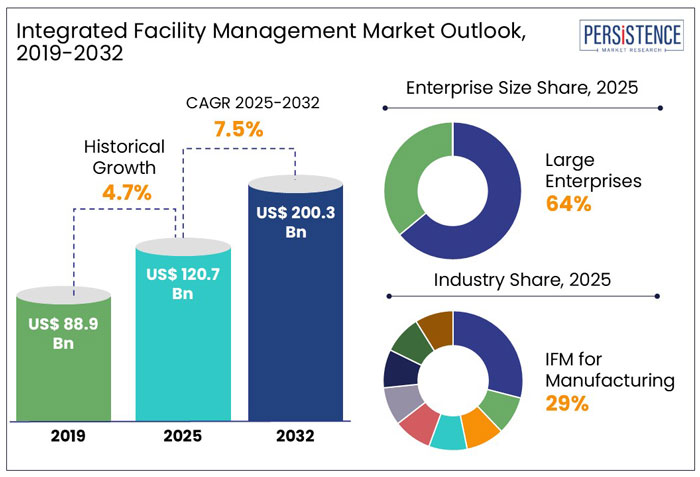Industry: IT and Telecommunication
Published Date: March-2025
Format: PPT*, PDF, EXCEL
Delivery Timelines: Contact Sales
Number of Pages: 250
Report ID: PMRREP3388
As of 2025, global demand for the integrated facility management market is estimated to be US$ 120.7 Bn and is forecasted to have a sales revenue of US$ 200.3 Bn by the end of 2032. The market is expected to expand at a CAGR of 7.5% throughout the forecast period, making it a key sector for businesses seeking streamlined facility solutions.
The unification of all internal strategy and facility management contracts under a single management team and system is known as integrated facilities management. The consolidation enhances oversight, communication, and efficiency while streamlining daily operational management.
Facilities management rarely starts with all vendors, projects, and employees listed on the same work or flow chart. It gradually integrates multiple aspects of business operations as improved coordination and employee participation highlight the responsibilities of a facilities management department and the potential locations for allocating resources for both internal and external buildings.
Modern IFM solutions provide clear and realistic insights into facility management operations and costs, allowing users to monitor maintenance performance easily using real-time data. It tracks work order performance to determine operational efficiency and responsiveness. This involves monitoring the percentage of completed work orders, the first-time fix rate (FTFR), and the backlog of open work orders to detect potential bottlenecks.
It improves equipment dependability by assuring high PPM Compliance (%) and extending asset life using favorable MTBF metrics. To balance proactive maintenance strategies, compare the ratio of preventive versus reactive maintenance tasks. Reduce utility operational costs while achieving sustainability goals by regulating energy consumption intensity (EUI) and lowering carbon footprint. It can track energy expenses per occupant and prevent peak surcharges.
In the current global environment, the industry is ideally situated to benefit from infrastructure investment. The majority of the services associated with the business, performances, and market expansion are represented by the market preference for remodelling existing structures. To maintain clean and green infrastructure, such as the development of smart buildings, government organizations in emerging countries enter into contracts with a variety of private contractors, including service providers and multinational companies.
In terms of the regional market landscape, North America held a dominant market share of 28.7% in the global landscape in 2024 and is expected to retain its dominant position throughout the forecast period. Meanwhile, demand for integrated facility management market in the European region accounted for a significant 25.1% share, highlighting its strong presence in the global landscape in 2024.

| Attributes | Key Insights |
|---|---|
|
Integrated Facility Management Market Size (2025) |
US$ 120.7 Bn |
|
Projected Market Value (2032) |
US$ 200.3 Bn |
|
Global Market Growth Rate (2025-2032) |
7.5% |
| IFM for Large Enterprises Market Share (2025) | 63.7% |
|
US Market Share (2024) |
14.5% |
| IFM for Manufacturing Market Share (2025) | 28.6% |
“Smart Tech and Automation are Driving IFM Growth in the U.S.”
The U.S. is the most lucrative market for integrated facility management in the North American region and is expected to maintain this position across the forecast period as well. With businesses rapidly adopting smart building technologies, data analytics, and automation, IFM providers are able to deliver more efficient and comprehensive solutions tailored to evolving operational needs.
The U.S. economy's vast scale and diversity also play a crucial role in bolstering the IFM market. With a multitude of industries ranging from manufacturing to healthcare, there is a consistent demand for facility management services. For instance, the manufacturing sector, which includes over 230,000 industrial production managers as of 2023, requires specialized facility management to oversee complex operations.
The U.S. has extensive commercial building infrastructure. According to the U.S. Department of Energy's Commercial Buildings Integration Program, commercial buildings account for a significant portion of the nation's energy consumption, with an average of 30% of the energy used in these buildings being wasted. This inefficiency presents a substantial opportunity for facility management services to introduce energy-saving measures, cutting operational costs while reducing environmental impact.
The growing adoption of advanced technologies, including building-integrated photovoltaics (BIPV) and AI-driven automation, is transforming facility management practices. As smart technologies continue to evolve, the IFM market in the U.S. is poised for tremendous growth, making it an exciting space for innovation and investment.
In 2024, the U.S. Integrated Facility Management companies helped the country to account for a dominant share of 14.5% in the global marketplace.
“China’s Real Estate and Infrastructure Investments are Shaping Business Growth”
In recent years, China's real estate market has faced significant challenges. In 2024, property investment dropped by 10.6%, while property sales measured by floor area declined by 12.9%. Additionally, new construction starts saw a sharp 23% decrease over the same period.
To stabilize and revitalize the sector, the Chinese government has rolled out targeted measures. By the end of November 2024, authorities had approved 3.6 trillion yuan (approximately $494.8 billion) in loans for "whitelist" development projects a key initiative designed to ensure the completion of stalled housing projects. As a result, 3.24 million housing units have already been delivered, helping to rebuild confidence among homebuyers and investors.
At the same time, infrastructure investment remains a government priority, with a 6% increase recorded in the first four months of 2024. This continued focus on large-scale infrastructure projects not only fuels the construction sector but also drives demand for facility management services to maintain and operate new public assets effectively. With these strategic efforts, China aims to restore stability in the property market while strengthening its long-term economic resilience.
The China integrated facility management market is estimated to expand at an impressive 8.3% CAGR over the next ten years.
“Germany’s Push for Energy-Efficient Facility Management”
Germany's commitment to sustainability and energy efficiency, as outlined in the Federal Ministry for Economic Affairs and Energy’s (BMWi) Energy Efficiency Strategy 2050, has set ambitious targets for reducing energy consumption in buildings. This policy framework encourages businesses to adopt integrated facility management (IFM) solutions that prioritize energy efficiency, driving significant demand in the sector.
At the same time, the rise of smart building technologies and the Internet of Things (IoT) is revolutionizing facility management. Real-time monitoring, predictive maintenance, and automation are making buildings more efficient and cost-effective. The German government's Digital Strategy 2025 further supports this transformation by providing incentives for companies to embrace digitalization and innovative facility management solutions. Additionally, Germany’s aging population and shrinking labor force are increasing the need for automation in facility management. Businesses are turning to AI-powered and IoT-driven solutions to enhance efficiency and reduce dependence on manual labor.
In 2024, Germany holds a 10.1% share of the global integrated facility management (IFM) market, reinforcing its position as a key player in the industry.
Which Enterprise Size Holds a Larger Share in the IFM Market?
“Large Enterprises Hold a Larger Share in the IFM Market”
In terms of enterprise size, the market is segmented into small and medium enterprises (SMEs) and large enterprises. The large enterprise segment is expected to hold a higher share of the market, accounting for more than 63.7% of the total market share in 2025. These organizations typically operate across multiple locations, making integrated facility management (IFM) solutions essential for streamlining operations, reducing costs, and maintaining consistent service quality. As businesses expand, managing vast assets such as office spaces, manufacturing plants, and data centers becomes increasingly complex.
Managing such large-scale projects requires sophisticated IFM solutions to oversee maintenance, security, compliance, and operational efficiency.
Why is Integrated Facility Management Popular in the IT & Telecom Industry?
Industry-wise, the market is divided into the following categories: BFSI, education, government, manufacturing, healthcare, retail & CPG, retail & CPG, travel & hospitality, and others. The IT & telecom sector is expected to lead this expansion.
The rise of cloud computing and data-driven applications has fueled the growth of data centers worldwide. These massive facilities require constant maintenance of cooling systems, power supply, and security measures to prevent downtime.
The rapid expansion of 5G technology is transforming the telecom industry. Unlike previous generations, 5G relies on small cell infrastructure and edge computing facilities, which require expert management at scale. The European Commission has emphasized the importance of an integrated telecom market, noting that the EU currently has 27 national telecom markets, each with its distinct regulations. This presents a huge opportunity for IFM providers to offer standardized facility management services across different countries, ensuring compliance and operational efficiency.
The adoption of Internet of Things (IoT) devices and artificial intelligence (AI) is adding even more layers of complexity to IT & Telecom infrastructure. Businesses need smart facility management solutions that can monitor, predict, and automate maintenance tasks in real time. This shift isn’t just about keeping systems running it’s about optimizing efficiency, reducing costs, and improving sustainability. As more companies integrate AI-driven facility management, the IT & telecom sectors will continue to see exponential growth in demand.
Companies continuously invest in technology and innovation. The integration of Artificial Intelligence (AI), Internet of Things (IoT), and cloud-based solutions enhances automation, predictive maintenance, and real-time monitoring. Companies differentiate themselves by offering cutting-edge solutions such as smart building management, energy efficiency optimization, and automated workflows that reduce operational costs for clients. Many providers form strategic alliances with hardware and software vendors to offer integrated solutions. These partnerships help expand service offerings, improve technological capabilities, and create bundled solutions that provide end-to-end facility management services.
Recent developments related to key players providing Integrated Facility Management have been tracked by the analysts at Persistence Market Research, which will be accessible in the full report.
| Attribute | Details |
|---|---|
|
Forecast Period |
2025-2032 |
|
Historical Data Available for |
2019-2024 |
| Market Analysis Units | Value: US$ Bn/Mn, Volume: As applicable |
|
Key Regions Covered |
|
|
Key Countries Covered |
|
|
Key Market Segments Covered |
|
|
Key Companies Profiled |
|
| Report Highlights |
|
|
Pricing |
Available upon Request |
Solution:
Enterprise Size:
Industry:
By Region:
To know more about delivery timeline for this report Contact Sales

In 2025, demand for integrated facility management markets for a valuation of US$ 120.7 Bn.
The globally integrated facility management market is estimated at 7.5%CAGR through 2032.
The market for integrated facility management is forecasted to climb to US$ 200.3 Bn by 2032-end.
Demand for Integrated Facility Management in India is projected to rise at 9.2% CAGR over the next ten years.
In 2024, the North American integrated facility management market held a dominant market share of 28.7%.